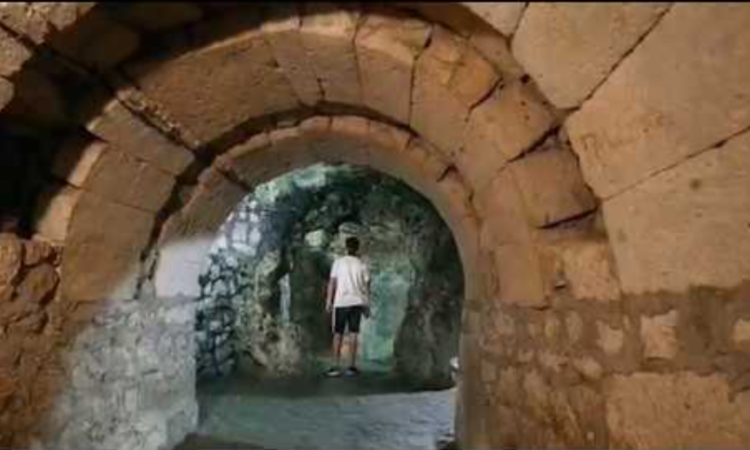A man finds an ancient city underground when he demolished a wall in front of his house

“This man knocked down a wall of his home and revealed an ancient underground city. [Music] Imagine doing some home remodeling work in your house and accidentally stumbling upon the entrance to a hidden underground city with significant archaeological importance. It may sound like the plot to a best-selling novel or action-adventure movie, but it actually happened in Turkey in 1963. Here is the incredible story of the ancient underground city of Derinkuyu and its modern discovery.

In 1963, a homeowner in the Nevşehir province near the Turkish city of Cappadocia was doing a renovation project when he tore down an old wall. He discovered a secret room hidden in his basement. This would be surprising enough, but after poking around the secret room, he made an even more startling discovery: there was a tunnel leading out of this hidden chamber that descended down into a mysterious labyrinth.
What this homeowner discovered in 1963 was one of the entrances to Derinkuyu, an ancient underground city that was constructed sometime between the 15th and 12th centuries BCE. Carved out of the soft volcanic rock, Derinkuyu was designed to stay hidden from view. Although there are several entrances to the underground city, they’re all obscured with a variety of ingenious objects. So is the complex network of ventilation shafts that brought oxygen into the subterranean city. Massive stone doors were found that closed from the inside. It’s obvious that the city was built to keep people out, but who?
Because the rocky ground on which the city of Cappadocia was built is so soft, it’s likely that early residents of the area first dug out small storage rooms or cellars beneath their homes. Because this was before you could just rent a locker from one of those guys at Storage Wars, the cool constant temperatures would have made it ideal for storing food. But the underground rooms also offered protection when the city was set upon by foreign invaders.
Archaeologists believe that the elaborate tunnels and chambers of the underground city were built to keep the citizens safe during invasions. Exactly which foreign invaders they hoped to keep out depends on who built the underground cities, which isn’t entirely clear. Archaeologists have two theories about who the builders could be.
The Hittites inhabited the area that is now Turkey as far back as 1600 BCE. By the middle of the 1300s BCE, the Hittite Empire had reached its height, extending across Asia Minor and into the upper Mesopotamian region. Although the Hittite Empire was sophisticated, the various cities of the Empire were besieged by outside forces on a regular basis, and eventually, the Empire collapsed. Many historians claim that the underground city of Derinkuyu and the others like it beneath Cappadocia were built by the Hittites to hide from the foreign invasions.
But there’s another theory. An alternate theory proposed by some historians and archaeologists claims that Derinkuyu was really constructed by the Phrygian people and that the tunnels were built between the 8th and 7th centuries BCE, making them younger than originally thought. The Phrygian people were accomplished builders and architects. They were responsible for completing several large complex building projects. Considered the greatest builders of the Iron Age, they had the skills to create an elaborate subterranean city.
Unfortunately, scientists cannot definitively date the tunnels because they’re made from stone, not organic material. Although archaeologists believe there could be hundreds of subterranean cities beneath Cappadocia, so far, we’ve managed to find a whopping six. One of the ones we know about, Derinkuyu, is the deepest, extending down about 280 feet over eighteen different levels.
The tunnel system was deliberately narrow so as to force enemy invaders to crawl through them one at a time. But once you conquer your claustrophobia, neat chambers open into huge rooms that could have housed tens of thousands of people. At the lowest level, the rooms are near enough to an underground river that the whole city had access to fresh drinking water.
Derinkuyu was designed so that everyday life would go on as usual even if the population was forced to hide out underground. The city had stalls for livestock, churches, schools, markets, and even a graveyard. When the city was excavated, archaeologists were surprised to find more than a hundred secret entrances into the underground city.
Like the entrance that was discovered in 1963, all the entrances were hidden throughout Cappadocia: in surface buildings, in courtyards and parks, in walls, and behind trees and bushes. Most likely these doors stood open when Derinkuyu was new so that the residents could access the tunnels quickly and easily. But now they’re like creepy little ancient Easter eggs.
Written records of the time, such as Anna Basses by Xenophon, mention that people lived in underground cities in Cappadocia. One such city, Kaymaklı, has been continuously inhabited since it was built. Excavation around Cappadocia seems to indicate that there are more subterranean cities just waiting to be discovered. It’s quite possible that the next home renovation projects undertaken in Turkey could be the first step in finding another one of these cities. It has, after all, happened before.




